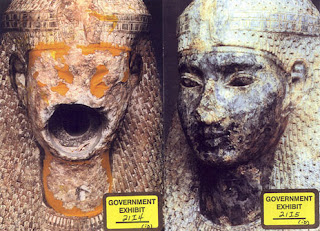Spotlighting Fake Antiquities with Record Keeping Laws
 |
| Fake Meryet Amun statue placed into evidence in U.S. v. Schultz. |
Fake antiquities can be found on internet auction sites and other sales venues. Moreover, there have been prominent cultural property cases featuring fakes, including the Arnold Peter Weiss case, where the convicted defendant possessed forged ancient coins, and the seminal case of U.S. v. Schultz, where a smuggler possessed a statue of the Egyptian princess Meryet Amun, which was a fake.
Just as record keeping laws can spotlight black market antiquities and bleach them from the legitimate marketplace, so too can the same laws protect consumers by helping authorities uncover fakes and forgeries offered for sale. A full description of the proposed statutes have been described in a prior blog post. In brief, the laws would require auction houses, dealers, galleries, shops, and other entities engaged in the antiquities trade to maintain records of the following:
• Descriptions of the names and addresses of the parties involved in a transaction, a description of the cultural object, and the amount of money exchanged.
• All available import documents and export permits connected with the object.
• A description of the provenance/chain of custody/collecting history of the object known to the seller or consignor along with supporting documents, photos, affidavits, and the like when available.
• Any condition reports associated with conservation reports, insurance documents, shipping paperwork, etc.
Such record keeping would help identify fraudulent merchandise and uncover falsely created documents that purport to “authenticate” cultural objects. The information would assist consumer protection authorities located at the Federal Trade Commission and at state attorneys general offices to more easily investigate and prosecute suspected fraudulent merchants.

